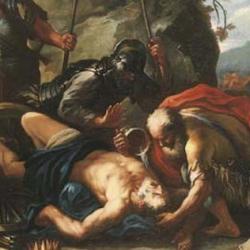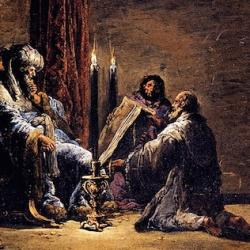The genealogy of Levi in 1 Chronicles 6 begins and ends with the genealogy of Aaron (6:1-15; 6:49-53). In between are two lists of the clans of Levi, the first a simple genealogy arranged according to the subclans of Kohath, Gershom, and Merari (6:16-30) and the second a genealogy of the Levitical singers, also arranged by subclans in the same order – Kohath, Gershom, and Merari (6:31-48). It makes a neat ABBA chiasm.
The introduction to the genealogies of the Levitical singers is chiastically arranged:
A. These are those whom David appointed, v. 31a
B. On the hand of song, v. 31b
C. In the house of Yahweh after the ark rested there, v. 31c
D. They did guard duty (mishartim) before the tabernacle with song, v. 32a
C’. Until Solomon built the house of Yahweh, v. 32b
B’. They served their office according to their service, v. 32c
A’. These are those who stood with their sons, v. 33a
The text centers of the service of song before the ark, describing with a term that in the Torah means “guard duty.” Song has a guarding function.
The genealogies themselves likewise emphasize the power of song. Each genealogy begins with one of the Levitical singers and works backward to Israel or to Levi. First there is the ancestry of Heman the Kohathite (the second-born song of Levi), then Asaph the Gershomite, then Ethan the Merarite. Asaph is said to be Heman’s brother “on the right hand” and Ethan “on the left.” The arrangement resembles that of Moses during the battle with the Amalekites (Exodus 17), where Aaron and Hur held up his arms so that he could hold up the Lord’s staff that gave them victory. Song guards; song is also a weapon of spiritual war, a staff of power raised before the God of Armies who gives victory. That suggestion in 1 Chronicles 6 is filled out elsewhere in Chronicles, as Israel defeats enemies by assembling the choir and singing her way to victory.











